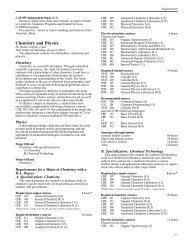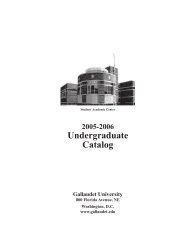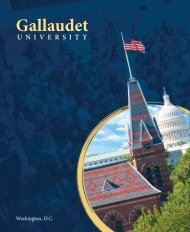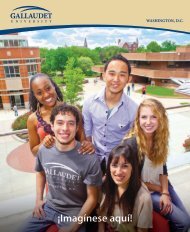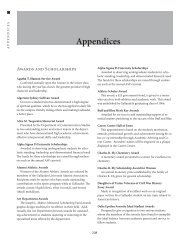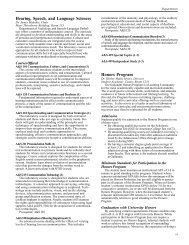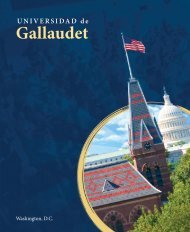catalog 04-05(update).indd
catalog 04-05(update).indd
catalog 04-05(update).indd
You also want an ePaper? Increase the reach of your titles
YUMPU automatically turns print PDFs into web optimized ePapers that Google loves.
Departments and Programs<br />
Accounting<br />
Please see Accounting major information and course listing<br />
under the Business Department.<br />
American Sign Language and Deaf Studies<br />
Dr. MJ Bienvenu, Chair<br />
Hall Memorial Building, Room E-111<br />
The Department of American Sign Language and Deaf<br />
Studies gives students an opportunity to acquire an understanding<br />
of the deaf community as part of human diversity.<br />
The courses are designed to prepare students to spend their<br />
professional or social lives after graduation in the deaf community<br />
or to make further contributions in a chosen academic<br />
discipline.<br />
The Department of ASL and Deaf Studies offers an<br />
introductory course (DST 101) to help all entering students<br />
develop a special focus on the sociological, historical, and<br />
linguistic aspects of deaf and hard of hearing people. If<br />
interested, students can then explore further by majoring in<br />
either ASL or Deaf Studies, providing that pre-major course<br />
requirements are met. Core programs in both majors are<br />
designed for students to develop a multidisciplinary approach<br />
in the areas of teaching, language, community, history,<br />
culture, and literature to the study of deaf and hard of hearing<br />
people.<br />
For information on linguistics and interpretation courses,<br />
please look under either the Linguistics or Interpretation<br />
Departments.<br />
Majors Offered<br />
American Sign Language<br />
Deaf Studies<br />
Minor Offered<br />
Deaf Studies<br />
34<br />
Requirements for a Major in American Sign<br />
Language<br />
Students must complete or demonstrate the following<br />
before declaring a major in ASL:<br />
A letter of interest.<br />
Three letters of recommendation<br />
A cumulative grade point average of 2.5 or better.<br />
A SCPI rating of Advanced Plus or better.<br />
A C+ or better in English 102 and 103, or the<br />
equivalent.<br />
An interview with at least 2 members of the<br />
program faculty.<br />
A grade of B or better in DST 101 and LIN 263.<br />
An ASL major must purchase a laptop and digital camcorder.<br />
To continue in the program, an ASL major must maintain a<br />
cumulative grade point average of 2.5 in major and related<br />
courses and can have no more than one D in his or her major<br />
courses.
Departments and Programs<br />
Required pre-major courses<br />
6 hours*<br />
DST 101 Introduction to Deaf Studies (3)<br />
LIN 263 Introduction to the Structure of American<br />
Sign Language (3)<br />
*Nine hours count toward the general studies requirements.<br />
Required major courses<br />
27 hours<br />
ASL 301 ASL and English: Comparative Analysis (3)<br />
ASL 303 Classifiers: Theory and Applications (3)<br />
ASL 3<strong>04</strong> Fingerspelling and ASL Numbers: Theory<br />
and Practice (3)<br />
ASL 3<strong>05</strong> Non-manual Grammatical Signals in ASL (3)<br />
ASL 314 ASL Literature (3)<br />
ASL 4<strong>05</strong> Discourse Features in ASL (3)<br />
ASL 421 Introduction to ASL Instruction (3)<br />
ASL 480 ASL Registers: Speaking to the Public (3)<br />
ASL 494 Senior Seminar (3)<br />
Required related courses<br />
DST 3<strong>05</strong> Deaf Culture (3)<br />
Elective courses<br />
Choose two courses:<br />
ASL 403 Communication in Gestures (3)<br />
ASL 495 Special Topics (3)<br />
ASL 499 Independent Study (3)<br />
DST 495 Special Topics (3)<br />
3 hours<br />
6 hours<br />
Courses encouraged, but not required<br />
HIS 331 History of the American Deaf Community(3)<br />
DST 312 Black Deaf People’s Studies (3)<br />
DST 313 Deaf Women’s Studies (3)<br />
DST/ART 315 Introduction to Deaf View/Image Art (3)<br />
Summary of requirements<br />
General studies courses<br />
Additional pre-major courses<br />
Major and related courses<br />
Free elective courses<br />
Total<br />
60 hours<br />
6 hours<br />
36 hours<br />
22 hours<br />
124 hours<br />
Requirements for a Major in Deaf Studies<br />
Students must complete or demonstrate the following<br />
before declaring a major in DST:<br />
A letter of interest.<br />
Three letters of recommendation from other faculty<br />
members<br />
A cumulative grade point average of 2.5 or better.<br />
An interview with at least two DST faculty<br />
members.<br />
A grade of B or better in DST 101, DST 201.<br />
A grade of C+ or better in ENG 103, or the<br />
equivalent, prior to declaring a major in Deaf<br />
Studies.<br />
To continue in the program, a DST major must maintain<br />
a cumulative grade point average of 2.5 in major and related<br />
courses and can have no more than one “D” in his or her<br />
major courses.<br />
Required pre-major courses<br />
15 hours*<br />
DST 101 Introduction to Deaf Studies (3)<br />
DST 201 Deaf Culture (3)<br />
HIS 111 American History I (3)<br />
HIS 112 American History II (3)<br />
SOC 101 Introduction to Sociology (3)<br />
*Twelve hours count toward the general studies requirements.<br />
Required major courses<br />
15 hours<br />
DST 311 Dynamics of Oppression (3)<br />
DST 314 Oral Traditions in the Deaf Community (3)<br />
DST 498 Senior Thesis (3)<br />
LIN 263 Introduction to the Structure of American<br />
Sign Language (3)<br />
HIS 331 History of the American Deaf Community(3)<br />
Elective major courses<br />
9 hours<br />
Choose three related courses:<br />
ASL 301 ASL and English: A Comparative Analysis(3)<br />
ASL 314 ASL Literature (3)<br />
DST 315 Introduction to Deaf View/Image Art (3)<br />
DST 316 Disability Studies (3)<br />
DST 401 Black Deaf People’s Studies (3)<br />
DST 402 Deaf Women’s Studies (3)<br />
Elective non-major courses<br />
9 hours<br />
Choose three courses:<br />
ASL 480 ASL Registers (3)<br />
COM 430 Gender and Communication (3)<br />
COM 440 Intercultural Communication (3)<br />
COM 450 Political Communication (3)<br />
EDU 250 Introduction to Education and Teaching (3)<br />
ENG 325 The Deaf in Literature (3)<br />
GOV 360 Public Policy (3)<br />
GOV 370 Human Rights (3)<br />
GOV 387 Nationalism and Developing Nations (3)<br />
HIS 322 Cultural Geography (3)<br />
HIS 332 History of Mass Media and the Deaf<br />
Community (3)<br />
HIS 378 U.S. Women’s History (3)<br />
HIS 380 The History of Sexuality (3)<br />
PSY 410 Psychology and Deaf People (3)<br />
PSY 448 Psycholinguistics (3)<br />
SOC 211 Race and Ethnic Relations (3)<br />
SOC 225 Sociology of Deafness and Deaf People (3)<br />
SOC 268 Cultural Anthropology (3)<br />
SOC 436 Social Inequality: Race, Class and Gender(3)<br />
SWK 318 Human Diversity (3)<br />
TFP 450 Deaf and Minority Representations in the<br />
Media (3)<br />
Summary of requirements<br />
General studies courses<br />
60 hours<br />
Major and related courses<br />
45 hours<br />
Free elective courses<br />
19 hours<br />
Total<br />
hours<br />
124<br />
Requirements for a Minor in Deaf Studies<br />
Students must pass DST 101 and DST 201 with a grade of<br />
“B” or better and a “C+” or better in ENG 103 or the equivalent<br />
prior to declaring a minor in Deaf Studies.<br />
Required pre-minor courses<br />
9 hours*<br />
DST 101 Introduction to Deaf Studies (3)<br />
DST 201 Deaf Culture (3)<br />
HIS 111 American History I (3)<br />
HIS 112 American History II (3)<br />
* Nine hours count toward the general studies requirements.<br />
Required minor courses<br />
12 hours<br />
DST 311 Dynamics of Oppression (3)<br />
DST 314 Oral Traditions in the Deaf Community (3)<br />
HIS 331 History of the American Deaf Community(3)<br />
LIN 263 Introduction to the Structure of American<br />
Sign Language (3)<br />
35
Departments and Programs<br />
Elective minor courses<br />
6 hours<br />
Choose two related courses:<br />
ASL 301 ASL and English: A Comparative Analysis (3)<br />
ASL 314 ASL Literature (3)<br />
ASL 480 ASL Registers (3)<br />
DST/ART 315 Introduction to Deaf View/Image Art (3)<br />
DST 316 Disability Studies (3)<br />
DST 401 Black Deaf People’s Studies (3)<br />
DST 402 Deaf Women’s Studies (3)<br />
Summary of minor requirements<br />
Pre-minor courses<br />
Minor courses<br />
Elective minor courses<br />
Total<br />
3 hours<br />
12 hours<br />
6 hours<br />
21 hours<br />
American Sign Language Courses Offered<br />
ASL 101 American Sign Language I (3)<br />
This course introduces the student to basic knowledge<br />
about American Sign Language and deaf people. Emphasis<br />
in the course is upon acquisition of both comprehension and<br />
production skills as well as upon knowledge of the deaf community<br />
and the development of cultural awareness necessary<br />
for maximal communication interaction. The student will begin<br />
with visual readiness activities and then progress through<br />
a group of targeted lexical items taught within meaningful<br />
contexts that stress use of questions, statements, commands,<br />
and conversational rules such as attention-getting and turntaking.<br />
Basic fingerspelling skills will also be stressed.<br />
Prerequisite: None. This course is designed to help the<br />
nonsigner and/or the beginning signer develop basic skills<br />
and knowledge in American Sign Language and deaf culture.<br />
ASL 102 American Sign Language II (3)<br />
This course is a continuation of ASL 101 and emphasizes<br />
expansion and refinement of the fundamental comprehension<br />
and production skills covered in ASL 101, with the acquisition<br />
of additional functional grammatical structure and targeted<br />
lexical items. Spontaneous, interactive use of American<br />
Sign Language is stressed through discussion of Gallaudetrelated<br />
events and activities, and the student will continue<br />
study of information related to everyday life experiences of<br />
deaf Americans and deaf people elsewhere in the world.<br />
Prerequisite: ASL 101 or departmental approval<br />
ASL 301 ASL and English: Comparative Analysis (3)<br />
This course covers areas of vocabulary, semantics, grammar<br />
and organization of ASL and English. Students look at<br />
the linguistic aspects of both languages and compare the two.<br />
The class also covers word classes and sentence structure<br />
of both languages. To assist students in understanding the<br />
structure of both languages, discussion of how languages<br />
work is included.<br />
Prerequisite: ENG 103 or equivalent<br />
ASL 303 Classifiers: Theory and Applications (3)<br />
This course introduces classifier theory and the three<br />
levels of complexity of classifiers. An understanding of<br />
classifier theory, which is one of the most complex areas of<br />
ASL linguistics, will enhance students’ understanding of<br />
ASL structure in general. Students will develop lesson plans<br />
and materials to teach ASL classifiers, as well as evaluation<br />
materials.<br />
Prerequisites: LIN 263; permission of the instructor<br />
ASL 3<strong>04</strong> Fingerspelling and ASL Numbers: Theory and<br />
Practice (3)<br />
This course introduces students to fingerspelling and<br />
numbers in ASL. The course covers topics such as techniques<br />
and forms of fingerspelling, when people fingerspell and how<br />
they use fingerspelling to meet their needs and numerical<br />
systems in ASL. Students will develop teaching materials<br />
and ways to assess the skills of their students.<br />
Prerequisites: LIN 263; permission of the instructor<br />
ASL 3<strong>05</strong> Non-manual Grammatical Signals in ASL (3)<br />
This course covers the non-manual aspect of the language.<br />
The upper part of the face demonstrates sentence types and<br />
the lower part demonstrates modifiers. Other parts of the<br />
body (e.g., shoulder shift, eye gaze) used to demonstrate<br />
grammar will also be covered. Students will do analysis of<br />
specific features (e.g., brow raise, clenched teeth) required<br />
for each aspect. Their development of or improvement on<br />
these skills is expected.<br />
ASL 314 ASL Literature (3)<br />
Study of selected videotapes and films ranging from<br />
the early 1900s to the present. Emphasis will be placed on<br />
historical background (deaf actors/actresses in silent films),<br />
meanings of the story content, discussion of grammatical features<br />
in ASL or ASL expressions signed by deaf people, and<br />
discussion of the various signing registers and styles revealed<br />
in these contents. A critical analysis of the value of available<br />
videotapes and films (appropriate selection of grammatical<br />
features, cultural information provided in the tapes, mannerisms);<br />
producing ASL literature in accordance with the<br />
development stage of readiness in elementary, secondary, and<br />
postsecondary students (making videotapes that are appropriate<br />
for various age groups).<br />
Prerequisite: LIN 263 or permission of the department<br />
chair<br />
Course fee: $45<br />
ASL 403 Communication in Gestures<br />
This course provides an introduction to communicating<br />
with gestures. Students learn to describe objects, ask for and<br />
give directions, discuss limited hypothetical issues, paraphrase,<br />
describe floor plans, and develop a skit through the<br />
use of gestures. The instructor uses gestures throughout the<br />
course.<br />
ASL 4<strong>05</strong> Discourse Features in ASL (3)<br />
This course demonstrates the use of space and eye gaze. It<br />
also demonstrates the use of role shifting to indicate speaker<br />
or locus of the subject/object in the ASL text. Organization<br />
of an ASL text and the function of these features will be covered.<br />
How they overlap with other features of the language<br />
will also be covered. Turn-taking regulators will be discussed<br />
within the conversation style of a discourse text.<br />
Prerequisite: ASL 303, 3<strong>05</strong><br />
ASL 421 Introduction to ASL Instruction (3)<br />
This course introduces ASL majors to the field of ASL<br />
instruction. Areas covered will be methods, curriculum and<br />
training in the field. Discussion of ASLTA certification will<br />
be covered as well. Students will be able to observe ASL<br />
classes to assist them in understanding the pedagogy of ASL<br />
teaching.<br />
Prerequisite: ASL 303, 3<strong>04</strong>, 3<strong>05</strong><br />
ASL 480 ASL Registers: Speaking to the Public (3)<br />
This course covers registers of ASL discourse -- frozen,<br />
formal, consultative, casual and intimate. Students will be<br />
able to discuss using ASL in the most common registers<br />
(formal, consultative and casual) in classrooms or at social<br />
events. They will also learn how to refine their skills in giving<br />
presentations using formal ASL.<br />
Prerequisites: ASL 303, 3<strong>05</strong>; COM 290<br />
36
Departments and Programs<br />
ASL 494 Senior Seminar (3)<br />
This capstone course is required for those students who<br />
complete the prerequisite courses, and it is to enable them<br />
to review their prior learning in the program. The course is<br />
also designed to give students the opportunity to develop an<br />
integrated approach to the study of ASL. Students will be<br />
expected to do at least one research paper on a selected topic<br />
to be approved by the faculty member.<br />
Prerequisite: ASL 303, 3<strong>04</strong>, 3<strong>05</strong>, 4<strong>05</strong><br />
ASL 495 Special Topics (1-3)<br />
Special topics in sign communication depending on the<br />
needs and interests of Gallaudet students. May be repeated<br />
for different topics.<br />
Prerequisite: Permission of the instructor<br />
ASL 499 Independent Study (1-3)<br />
A project in the area of the student’s special interest as<br />
it relates to sign communication. Title indicating the content<br />
must be available at time of registration.<br />
Prerequisite: Permission of the department chair<br />
ASL 695 Special Topics (1-3)<br />
ASL 699 Independent Study (1-3)<br />
Prerequisite: Permission of the instructor<br />
Deaf Studies Courses Offered<br />
DST 101 Introduction to Deaf Studies (3)<br />
This course helps students to appreciate deaf culture,<br />
American Sign Language, and the deaf community as<br />
contributors to the heritage in the United States and abroad.<br />
It gives students a chance to reevaluate these contributions<br />
through scholarship and research in advanced courses.<br />
Prerequisite/corequisite: ENG 080 or the equivalent<br />
DST 3<strong>05</strong> Deaf Culture (3)<br />
This is a survey of the various areas of study of deaf culture<br />
in the United States (history, folklore, anthropology, and<br />
sociology).<br />
Prerequisite: DST 101<br />
DST 311 Dynamics of Oppression (3)<br />
This course examines various forms of oppression by<br />
looking across different cultures and communities, then<br />
examines possible parallels occurring within the deaf community.<br />
Prerequisite: DST 101<br />
DST 314 Oral Traditions in the Deaf Community (3)<br />
The dynamics of oral cultures and their traditions will be<br />
introduced in this course by studying the development of oral<br />
literature and literary artists in other cultures. Then using this<br />
as background, attempts will be made to study ASL literary<br />
tradition by looking at life histories, narratives, and poetry<br />
performances.<br />
Prerequisites: DST 101, 3<strong>05</strong><br />
DST 316 Disability Studies (3)<br />
This course will introduce students to the field of Disability<br />
Studies. As an emerging interdisciplinary field of study,<br />
Disability Studies does not approach disability as a “medical<br />
condition, but as a human condition” (Charlton). Instead<br />
of studying the causes and rehabilitation of persons with<br />
disabilities, we will explore the historical, social, political,<br />
religious, philosophical, and cultural influences that “construct”<br />
the category of “disability.” We will also examine<br />
how persons with disabilities construct their own meanings<br />
and identities.<br />
Prerequisite: DST 101<br />
DST 401 Black Deaf People’s Studies (3)<br />
This course primarily examines black deaf people in<br />
America including the Caribbean Islands and Africa. The<br />
course is organized to focus on the history, education, community<br />
and culture, language, and psychosocial forces that<br />
influence black deaf people’s experience. It will concentrate<br />
on the social, political, and cultural development of a unique<br />
group of people that is a part of the general deaf community<br />
and the black community.<br />
Prerequisites: DST 101, 3<strong>05</strong><br />
DST 402 Deaf Women’s Studies (3)<br />
This course will explore how the field of women’s studies<br />
came into being by way of the 1848 Seneca Falls Convention.<br />
Issues faced by both hearing and deaf women will be<br />
investigated: career, educational opportunities, reproduction,<br />
and patriarchy, among others.<br />
Prerequisites: DST 101, 3<strong>05</strong><br />
DST 494 Senior Seminar (3)<br />
The seminar gives students the opportunity to develop an<br />
integrated approach to the study of deaf and hard of hearing<br />
people in American and abroad. Students will be asked to<br />
investigate a particular topic in depth.<br />
Prerequisites: Successful completion of the core major<br />
program with a GPA of 2.5 or better<br />
DST 495 Special Topics (1-3)<br />
Topics not taught in other courses.<br />
DST 498 Senior Thesis (3)<br />
This course allows interested seniors to study a specialized<br />
topic of their choice in depth. It encourages the students to<br />
conduct a case study or cross-cultural comparative study in<br />
consultation with the Deaf Studies Department and another<br />
appropriate department or research program.<br />
Prerequisite: Permission of the department chair<br />
DST 499 Independent Study (1-3)<br />
DST 315 Introduction to Deaf View/Image Art (3)<br />
This course is cross-listed and is otherwise known as<br />
ART 315. This course introduces a humanistic perspective<br />
on De’VIA and deaf artists. Deaf View/Image Art (De’VIA)<br />
refers to works by artists who express their Deaf experiences<br />
through visual art. Students will also explore how other<br />
minority groups (such as feminists, African Americans, Native<br />
Americans, etc.) use art as an expression of resistance.<br />
This course involves slide presentations of minority arts and<br />
De’VIA and group discussions.<br />
Prerequisite: DST 3<strong>05</strong><br />
37



